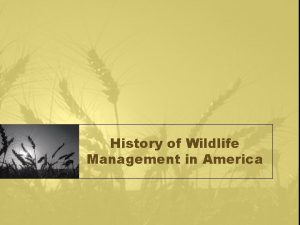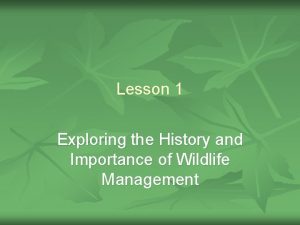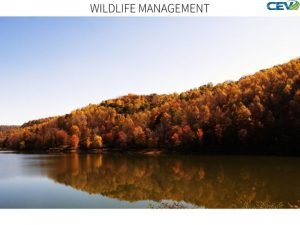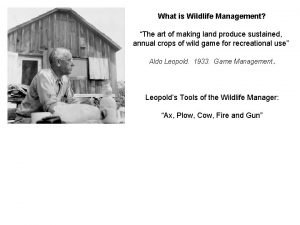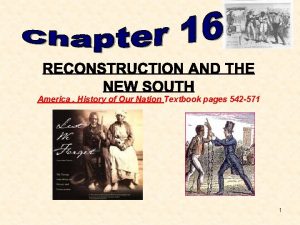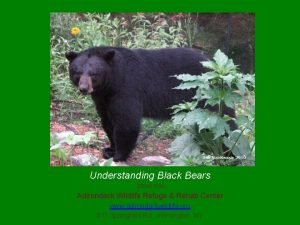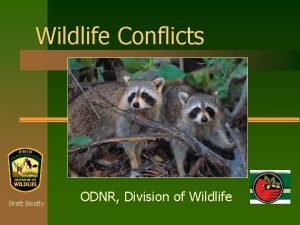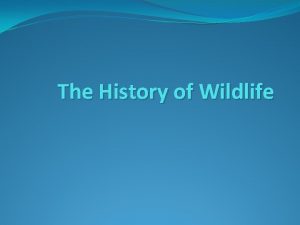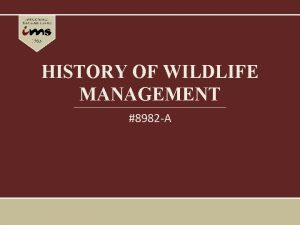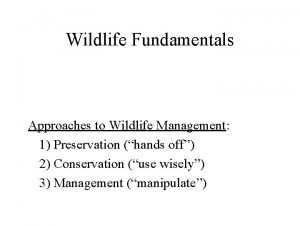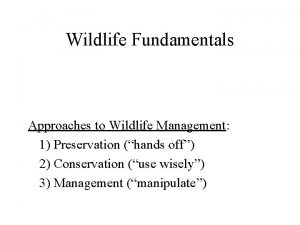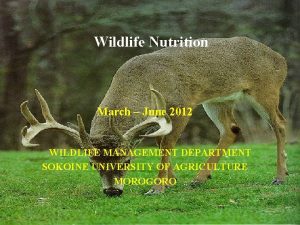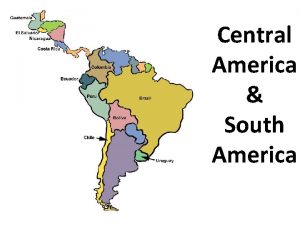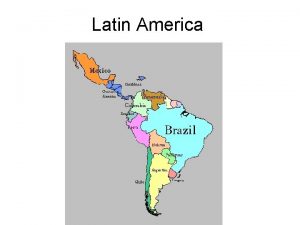History of Wildlife Management in America Wildlife Management
























- Slides: 24

History of Wildlife Management in America

Wildlife Management • Has evolved during the past 75 to 100 years • In the past, wildlife management was pushed aside in the rush to settle America. • This resulted in the loss of wildlife habitat, loss of entire species, and endangerment of other species. • Management attempts began in the early 1800’s.

• New settlers almost died of starvation and malnourishment. • They quickly learned to hunt, fish, and exploit the abundant wildlife. • More settlers came and the pressure on America’s wild FAUNA increased.

• Due to different climate and soils, it took almost 200 years for agriculture to get a firm grip. • Therefore, American wildlife fed, clothed, and made money for settlers. • 1700 -1900: The greatest abuse of wildlife.

• Millions of acres of • Seasons were largely habitat were ingnored destroyed for homes, – Why do you think they were ignored? towns, and farms. • Deer were hunted 365 d. of the year- by 1776 all southeastern states (except Georgia) had a closed deer season.

• Rural families = more that 90% of the population • Shot anything they could eat or that threatened them. • Some practices were beneficial to some species. – Ex: Clearing land for crops benefited whitetailed deer, and their predators were being systematically destroyed.

• Forests were cut and • The English settlers burned, leading to began to pave, build, turkeys and create over the passenger pigeons wilderness. losing their • The large number of reproduction grounds. wild creatures vastly diminished.

• Bison and pronghorns were threatened as well. • Early conservationists ensured that they still exist today, unlike the passenger pigeon. • Due to sport hunters and conservationists, many species are still abundant today.

Exploitation • From the earliest • This would forever alter North beginnings, America and its English settlers had no intention of wildlife adapting to the • The French wilderness. Unlike became bounty the French to the hunters, trappers, north. and gatherers of – Set out to clear the wilderness. forest and build towns, cities, and roads.

• Some thought is being given today to the damage our construction is having on wildlife. – Once a piece of land is paved, its use as a source of wildlife habitat is ended!

Conservation Begins • Early 1870’s: Serious effort to protect and preserve America’s wild FAUNA. • They worked to change the views on the commercialization of wild game. • Market hunters played a huge role in eliminating much of America’s wildlife. – What are market hunters?

SPORT HUNTING HAS NEVER ENDANGERED A SINGLE SPECIES!

• Market hunters: kill for • Sport hunters: Use money, kill the sporting methods and surplus and cut into regulate their harvest the breeding stock. Wildlife are vulnerable when unsporting tactics are used. – For example: Ducks, geese, and wild turkeys are relatively easy to bait with corn.

• Sport hunters were interested in the protection of game animals. • Trends in fashion led to large concentrations of birds being harmed and exploited. • Sport hunters used the Boone and Crockett Club and publications to change views on market hunting.

Progress is FINALLY made!!!!

The Lacey Act • The Lacey Act of • Work of John F. Lacey, an avid 1900: – Ended market hunting – Ended interstate shipment of wildlife and wildlife products hunter and fisherman.

Theodore Roosevelt • Deep love of big • However, he could game hunting. not openly establish them – it would have • Strong responsibility been political suicide. to preserve remaining wildlife. • Created more than 50 refuges, 5 national parks, and 17 national monuments.

Aldo Leopold • “First” Professional Wildlife Manager • First book, Game Management, advanced many new concepts. • Taking a census of the wildlife populations. • “Home range” theory • Management plans based on: reproduction, predators, food, water, shelter, etc

Yellowstone • Yellowstone National Park was the first national park. • Founded in 1872 • Established through the efforts of sport hunters to preserve a unique piece of the west. • Took more that 20 years to get the protection it now has.

National Parks • Weren’t always protected from poachers. • Today they are wildlife and wilderness sanctuaries. • Restocking efforts were possible because of national parks and other sanctuaries. • National parks and forests practically ensure the existence of some wildlife as long as the refuges remain.

Migratory Birds • Migratory Bird Conservation Act of 1929 – Important to the recovery of waterfowl populations. – Cooperative Agreement between U. S. , Canada, and Mexico.

Migratory Birds • Migratory Bird Hunting Stamp Act of 1934 – Often called the Duck Stamp Act – Provides millions of dollars for waterfowl management through the sale of stamps to hunters.

Federal Aid • 1937: The Federal Aid in Wildlife Restoration Act was passed. • Commonly referred to as the Pittman. Robertson Act. • Called for a 10% excise tax on firearms and ammunition. • Collected directly from the manufacturers and provides most of the funding for wildlife departments in all 50 states. Video

Pittman Robertson Act • The excise tax was raised to 11% in 1941 • 1970: 10% tax on handguns • 1971: 11% tax on archery equipment • There is a similar tax on fishing equipment • These taxes helped: – Wildlife management, research, and protection. – Acquire millions of acres of habitat.
 History of wildlife management
History of wildlife management History of wildlife conservation
History of wildlife conservation Rap of the states
Rap of the states Europe asia north america south america
Europe asia north america south america Repetition in let america be america again
Repetition in let america be america again Why is latin america called latin america
Why is latin america called latin america Happening body art
Happening body art Manipulative management wildlife
Manipulative management wildlife Objectives of wildlife management
Objectives of wildlife management Careers in wildlife management
Careers in wildlife management Wildlife management as an art
Wildlife management as an art Deaf education history
Deaf education history America history of our nation textbook
America history of our nation textbook Adirondack black bears
Adirondack black bears Gdt european wildlife photographer of the year
Gdt european wildlife photographer of the year Climate soil and natural vegetation of karnataka
Climate soil and natural vegetation of karnataka Animal depletion
Animal depletion Wildlife topics for presentation
Wildlife topics for presentation Explain wildlife
Explain wildlife Shillapoo wildlife area
Shillapoo wildlife area Wildlife corridor design
Wildlife corridor design Wildlife reproduction
Wildlife reproduction Cascade mountains wildlife
Cascade mountains wildlife Odnr division of wildlife
Odnr division of wildlife Boreal shield vegetation
Boreal shield vegetation
